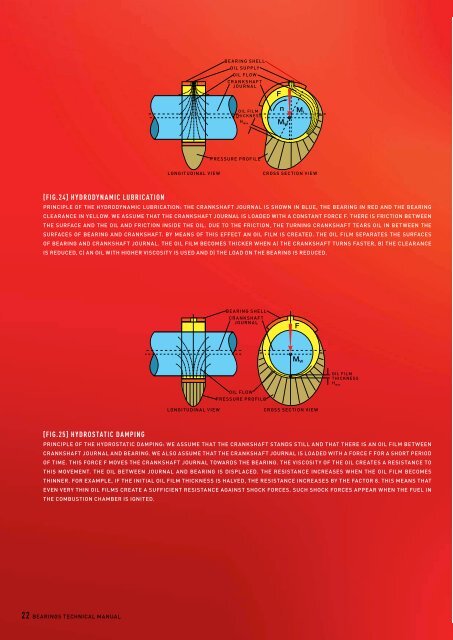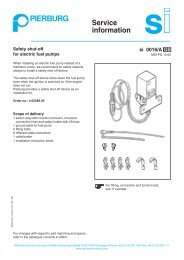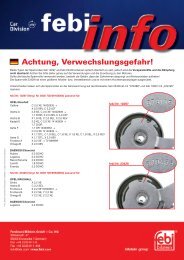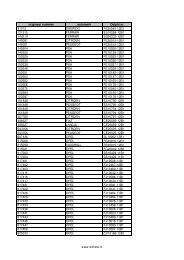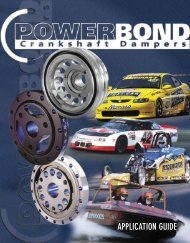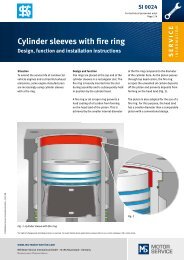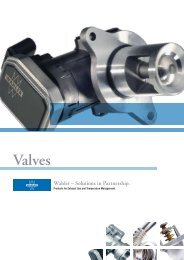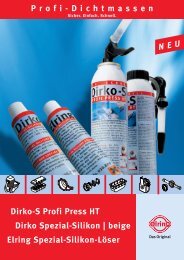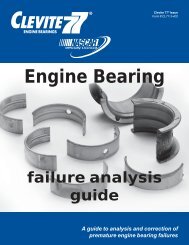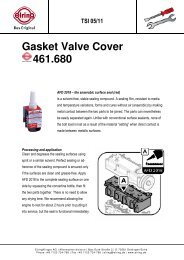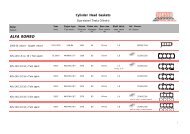EvEry bEaring you nEEd
EvEry bEaring you nEEd
EvEry bEaring you nEEd
Create successful ePaper yourself
Turn your PDF publications into a flip-book with our unique Google optimized e-Paper software.
[fig.24] Hydrodynamic lubrication<br />
longitudinal view<br />
bearing shell<br />
oil supply<br />
oil flow<br />
crankshaft<br />
journal<br />
oil film<br />
thickness<br />
h min<br />
pressure profile<br />
bearing shell<br />
crankshaft<br />
journal<br />
F<br />
n<br />
M W<br />
M L<br />
cross section view<br />
principle of the hydrodynamic lubrication: the crankshaft journal is shown in blue, the bearing in red and the bearing<br />
clearance in yellow. We assume that the crankshaft journal is loaded with a constant force f. There is friction between<br />
the surface and the oil and friction inside the oil. Due to the friction, the turning crankshaft tears oil in between the<br />
surfaces of bearing and crankshaft. By means of this effect an oil film is created. The oil film separates the surfaces<br />
of bearing and crankshaft journal. The oil film becomes thicker when a) the crankshaft turns faster, b) the clearance<br />
is reduced, c) an oil with higher viscosity is used and d) the load on the bearing is reduced.<br />
F<br />
The physics of lubrication<br />
One of the oil film’s functions is to separate the bearings from the<br />
crank pins. When discussing lubrication we distinguish between<br />
two physical effects: hydrodynamic lubrication, which is caused<br />
by rotation and hydrostatic damping, which cushions shock load.<br />
In an internal combustion engine the two effects overlap.<br />
Hydronamic lubrication<br />
Figure 24 explains the principle of hydrodynamic lubrication. A<br />
shaft on which a force is acting is rotating in its bearing. The bearing<br />
is supplied with oil from above via the oil borings. Through<br />
friction the shaft draws oil through the lubrication gap and creates<br />
the oil film. The oil film produces an even distribution of<br />
pressure that separates the shaft from the bearing. However, the<br />
oil is not only drawn through the lubrication gap but also flows<br />
laterally out of the bearing.<br />
Hydrostatic damping<br />
The principle of hydrostatic damping is illustrated in Figure 25. In<br />
the case shown, the shaft and pins are separated from each other<br />
by the oil film. A periodic load is suddenly imposed from above,<br />
for instance via the ignition of the combustion of the fuel-air mix<br />
in the combustion chamber. This periodic force displaces the oil,<br />
driving it in all directions out of the lubrication gap between shaft<br />
and bearing. The greater the oil’s viscosity, the greater the resistance<br />
to this displacement process, and resistance to it increases<br />
greatly as the thickness of the lubricant film decreases. The oil’s<br />
resistance to displacement thus prevents the shaft and bearing<br />
from coming into contact during the imposition of a periodic load<br />
of brief duration.<br />
[fig.26]<br />
Combustion and inertia forces move the crankshaft journal<br />
inside the bearing. The illustration shows a typical journal<br />
orbit of a crankshaft journal in a con rod bearing (bearingfixed<br />
view). The distance between the surfaces of bearing and<br />
crankshaft journal is indicated as ∑ at ∑ = 0, the crankshaft<br />
journal is in the middle of the bearing, at ∑ = 1, crankshaft<br />
journal and bearing touch each other. As can be seen, the<br />
smallest distances appear in the upper shell of the bearing<br />
for a relatively long way of the journal orbit. This explains<br />
why the wear is higher in the upper shell than in the lower<br />
shell of a con rod bearing.<br />
[fig.25] Hydrostatic damping<br />
longitudinal view<br />
oil flow<br />
pressure profile<br />
M W<br />
cross section view<br />
oil film<br />
thickness<br />
H min<br />
principle of the hydrostatic damping: we assume that the crankshaft stands still and that there is an oil film between<br />
crankshaft journal and bearing. We also assume that the crankshaft journal is loaded with a force f for a short period<br />
of time. This force f moves the crankshaft journal towards the bearing. The viscosity of the oil creates a resistance to<br />
this movement. The oil between journal and bearing is displaced. The resistance increases when the oil film becomes<br />
thinner. For example, if the initial oil film thickness is halved, the resistance increases by the factor 8. This means that<br />
even very thin oil films create a sufficient resistance against shock forces. Such shock forces appear when the fuel in<br />
the combustion chamber is ignited.<br />
Both combustion forces and inertial forces are acting on the<br />
shaft. These forces ensure that the crank pins describe a complex<br />
displacement path within the bearing (Figure 26). The minimum<br />
lubrication film thickness, i.e., the smallest gap between crank pins<br />
and bearings, occurs during the combustion process. Calculations<br />
have shown that this gap can be less than one micrometer.<br />
Efficiency of Filter (%)<br />
Particle Size (µm)<br />
Dirt problems<br />
The effectiveness of a typical paper oil filter is charted in Figure<br />
27. Contaminant particles with diameters greater than 25 μm will<br />
be filtered out of the oil with a high probability of passing the<br />
oil filter once. However, the smaller the contaminant particle, the<br />
lower the probability that it will be intercepted by the oil filter,<br />
and in our example a particle 5 μm in diameter will only be intercepted<br />
in a relatively low number of all cases.<br />
Thus most of the smallest contaminant particles will not be stopped<br />
by the oil filter. However, they are capable of damaging bearings<br />
and crank pins. This consideration makes clear the importance of<br />
ensuring absolute cleanliness when overhauling an engine.<br />
[fig.27]<br />
Efficiency of a typical paper oil filter depending<br />
of the size of the dirt particles in the oil when<br />
the oil passes the filter once.<br />
22 Bearings Technical Manual<br />
23


